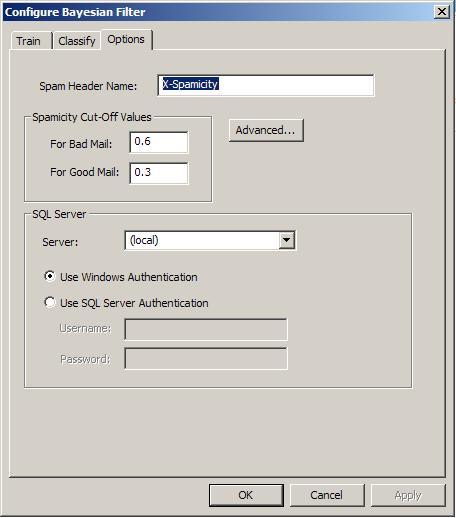

The Options tab page provides control for several elements used for the Bayesian filtering.
This is the name of the message header that is inserted with classification determination and corresponding spam probability index. By default the header is called X-Spamicity.
The Bayesian determination of whether the message being analyzed is spam or ham is based on comparing the computed spam probability index to the cut-off values in the fields shown above.
In Praetor, the following spam probability value ranges are set as the defaults used in classifying the messages using the Good Mail cut-off value of 0.10 and Bad Mail cut-off value of 0.95.
|
Probability value |
Classification |
Suggested action |
|
less than 0.30 |
Ham or good email |
Accept |
|
0.30 ~ 0.60 |
Unsure |
Accept or Quarantine |
|
greater than 0.60 |
Bad email or spam |
Quarantine or Reject |
At these values, Praetor will be very accurate in its classification of spam and ham such that those classified as ham will definitely be ham, and those classified as spam will also accurately be spam. The potential problem with the wide range for the unsure class will be in ham getting mixed in. Naturally there will also be a lot of spam classified as unsure. Depending on your sensitivity to this situation, it is likely you will want to adjust these cut-off values to narrow the range of such uncertain messages.
This group box allows you to choose on which SQL server the PraetorClassify database resides, which contain the message tokens used for Bayesian classification. If necessary you can also specify the authentication method used to connect to that database server.
![]() Note:
Note:
|
Since this token database has been separated from the normal Praetor log database, it is possible for multiple Praetor machines to share the same database. In this way, the computed spamicity value will be the same regardless which Praetor machine handles the message. |
By default, the SQL database resides on the same machine as Praetor G2, implemented using the Microsoft SQL Desktop Engine (MSDE). You can, however, choose a different SQL Server using the drop-down list which will automatically get populated from all the available servers found in your network.
Once the SQL Server has been selected or a name entered, you may choose to use either Windows or SQL Server authentication method. If Windows authentication is selected, then Praetor will use the login originally established when it was installed. If you select SQL Server authentication, you will need to provide the login account and its password.
If your SQL Server is on the Praetor machine, chances are that you installed SQL Server while MSDE was still present. During such an installation you would have been prompted for an instance name and the entry that is needed by Praetor will be in the form MACHINE_NAME\INSTANCE_NAME.